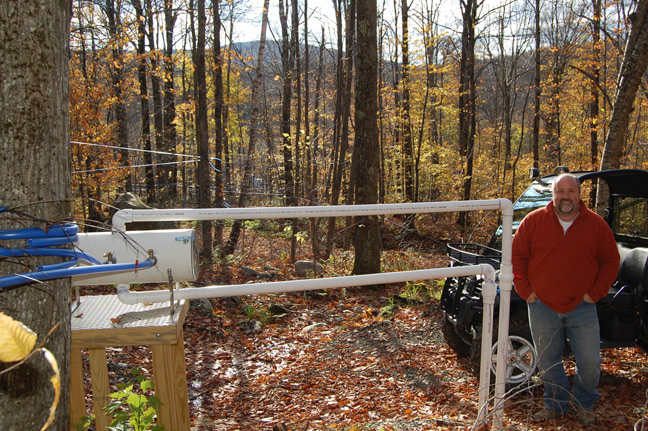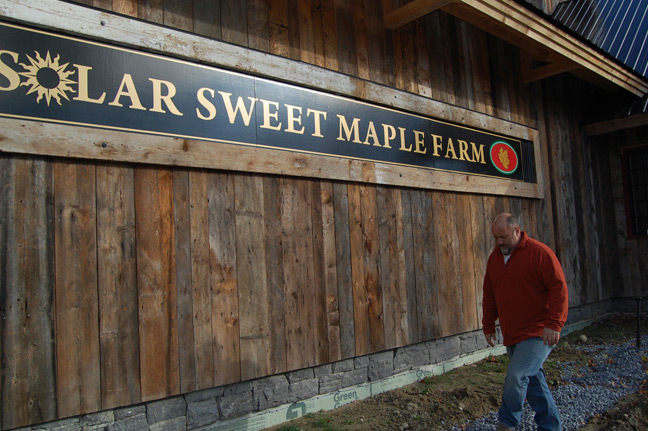Sugarmaker Profiles
Green Giant
Solar Sweet Sugar House in Lincoln, VT
By PETER GREGG |
LINCOLN, Vt. — The nation’s first all green sugarhouse is perhaps also among the biggest.
Tom and Rhonda Gadhue, owners of Solar Sweet Sugar House in Lincoln, Vt. wanted not only to go all in when building his brand new 15,000-tap dream operation in 2011, he wanted to go all green as well.
“This is a new green twist on an old Vermont tradition,” Gadhue said, standing inside the cathedral-like 4,000 square foot sugarhouse, tucked into a slope in the shadow of Mt. Abraham in the central part of the state.
“We’re shooting for a zero net carbon footprint. That’s what our goal is.”
He’s off to a good start.
The signature feature of the facility is the bank of solar panels on the south facing roof. The panels generate about 12,000 kilowatts of power annually, which is roughly the sum power usage of the operation during sugaring season.
Gadhue is allowed to bank power credits with his power company throughout the year and apply those credits to his usage during the season.
It gets better. Because of green incentive laws in Vermont that reward solar energy, Gadhue is given an extra nickel per kilowatt that he produces from his panels, meaning that he will actually make a profit on his energy production.
The sugarhouse is sided with recycled wood from two torn down barns in a neighboring county. Inside, the boiling room is lit with LED lighting. A high efficiency wood boiler heats the facility.
The sugarhouse has many other green features.
All of the vacuum pumps inside the sugarhouse have “slow start” variable speed drives on a float system, which use much less energy than conventional extractors that draw big amperage when they fire up.
In the woods, Gadhue uses all 100 percent food grade tubing. All of his mainline tubing is buried four feet in the ground, keeping sap cool on the way to the sugarhouse and protecting it from critter damage. All of the 28 boosters are monitored with cameras linked back to a video panel in the sugarhouse, allowing Gadhue to spot and fix a leak within 10 minutes, he said.
“We’re pushing technology as far as it can go,” he said.
Back in the sugarhouse, the 6 x 16 Dominion & Grimm rig is fueled with wood gasification technology, with temperature probes placed strategically throughout the arch and dampers to adjust firing temperatures.
The rig is remarkably efficient. Gadhue says he only has to fire once every 45 minutes. He said he made 4,000 gallons of syrup last season on only 12 cords of wood.
In the RO room, the massive RO unit features a reverse flow component, allowing for less wear and tear on the end membranes, he said.
When Gadhue approached his D&G dealer in Georgia, Vt. about his plans for customizing his equipment to make it as green as possible, “they thought I was crazy,” he said.
While he had to pay more for the equipment, Gadhue said in the long run it is a better set up.
“The costs of fuel and power are not going down,” he said. “We’re gonna end up ahead of the game.”
Gadhue got the idea for the all green concept from his son Ryan, an environmental studies major in college, when the two were on a road trip.
“We were up through the middle of the night sketching out new idea after new idea,” Gadhue recalled. “It was exciting.”
Plans for the future include expanding to 25,000 taps or more, one of many operations in the Green Mountain State going from zero to 25,000 taps or more within just a season or two. The operation is financed through Yankee Farm Credit.
It’s not just the energy and efficientcy savings that will benefit the operation. Gadhue said the marketing value of an all green sugaring operation is also noteworthy.
“When customers find out our syrup was made with consciousness, we hope to get a premium for our product,” he said. “It gives us a little better twist.”
BY THE NUMBERS:
Solar Sweet Sugar House, Lincoln Vt.
15,000 taps (going to 25,000+)
4,000 gallons of syrup
12 cords of wood
6,000 gph boiling rate
4,000 sq ft sugarhouse
12,000 kw of power generated
12,000 kw of power used
Zero net power usage
November 2012





































